
* The Chance Vought company encountered difficulties in moving into the jet age, developing the disappointing "Pirate" and then the downright dreadful "Cutlass" jet fighters. However, the company was able to recover their fortunes and then some with the outstanding "Crusader" fighter, and refined the aircraft through a series of variants and updates.
* Although the Vought company had built the superlative F4U Corsair fighter for the Allied war effort during World War II, after the war the company found the transition to the jet age difficult.
The company's first attempt to build a jet fighter was the "F6U-1 Pirate". This aircraft evolved out of a requirement issued by the US Navy's Bureau of Aeronautics ("BuAer") issued on 5 September 1944, specifying a single-seat carrier-based fighter powered by a Westinghouse 24C (later J34) turbojet. On 29 December 1944, Vought was awarded a contract for three prototypes, with the initial "XF6U-1" prototype flying on 2 October 1946.
The Pirate was an uninspired design, featuring a cigar-shaped fuselage with engine intakes under the wing roots and exhaust in the tail, fitted with straight wings mounted mid-body and straight tail surfaces. The aircraft had tricycle landing gear; four M3 20-millimeter cannon mounted under the nose; arresting gear; and optional wingtip tanks with a capacity of 530 liters (140 US gallons) each. The aircraft featured unusual construction techniques, including "Metalite" skinning of balsa sandwiched between two thin sheets of aluminum, and "Fabrilite" skinning of balsa sandwiched between sheets of fiberglass for the tailfin and air intakes.
The first XF6U-1 prototype was powered by a J34-WE-22 turbojet with 13.3 kN (1,360 kgp / 3,000 lbf) thrust. That was only about half the empty weight of the aircraft, and so the prototype was painfully underpowered. To help improve the machine's performance the third prototype, which first flew on 10 November 1947, was fitted with an afterburning engine, the first US Navy fighter with such a powerplant.
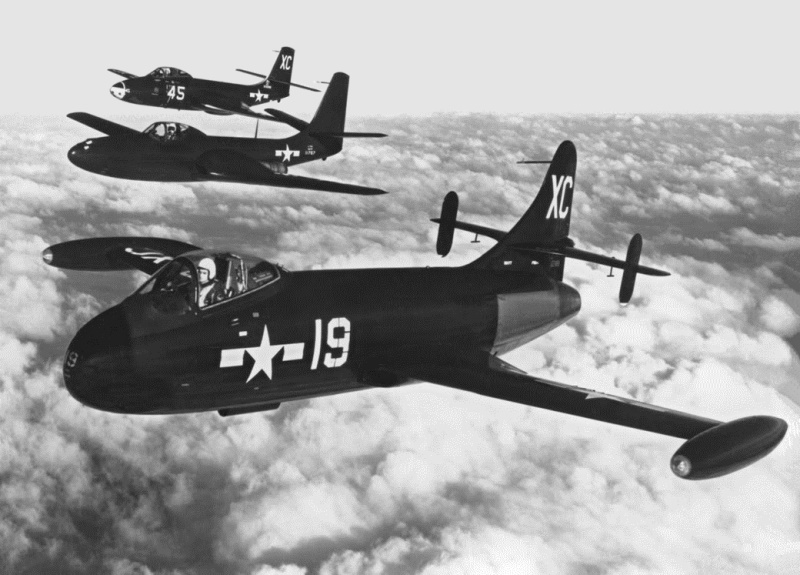
The Pirate also had poor handling characteristics. Various changes were implemented during the flight test program in hopes of improving them -- most visibly the addition of small "finlets" near the ends of the tailplane. Despite the problems with the aircraft, the Navy continued to hope that the bugs could be worked out, and ordered 65 production "F6U-1" fighters. They were to be fitted with an afterburning J34-WE-30A engine, with dry thrust of 14.0 kN (1,430 kgp / 3,150 lbf) and afterburning thrust of 18.2 kN (1,860 kgp / 4,100 lbf).
___________________________________________________________________
VOUGHT F6U-1 PIRATE:
___________________________________________________________________
wingspan:
10 meters (32 feet 10 inches)
wing area:
18.90 sq_meters (203.5 sq_feet)
length:
11.48 meters (37 feet 8 inches)
height:
3.93 meters (12 feet 11 inches)
empty weight:
3,320 kilograms (7,320 pounds)
loaded weight:
5,850 kilograms (12,900 pounds)
max speed at altitude:
960 KPH (595 MPH / 520 KT)
service ceiling:
14,100 meters (42,260 feet)
range with tanks:
1,880 kilometers (1,770 MI / 1,540 NMI)
___________________________________________________________________
The first production F6U-1 performed its initial flight on 5 March 1949, and numbers of the aircraft were provided to a Navy operational evaluation squadron. The judgement from the evaluation was that the Pirate was unacceptable. On 30 October 1950, the BuAer informed Vought of the Navy's opinion of the Pirate in terms both bureaucratic and scathing: "The F6U-1 had proven so sub-marginal in performance that combat utilization is not feasible." Only 30 Pirates were built from the production order of 65, to be assigned to test and evaluation roles for a few years, then scrapped. One was fitted with cameras for the photo-reconnaissance role and designated "F6U-1P".
BACK_TO_TOP* The Pirate suffered from being too unambitious, but that could be forgiven. Most US aircraft manufacturers were still trying to figure out what could be done with jet propulsion, and a few dead ends were no surprise. Vought tried harder on their second next jet fighter design, the "F7U Cutlass", but ended up suffering from being too ambitious.
The Cutlass grew out of a US Navy requirement issued on 1 June 1945 for a high-performance shipboard jet fighter. Vought replied with a proposal designated "V-346", and the Navy awarded the company a contract for three "XF7U-1" prototypes on 25 June 1946. The first prototype Cutlass flew on 29 September 1948. Fourteen pre-production "F7U-1s" had been ordered on 29 July 1948, with the first flying on 1 March 1950.
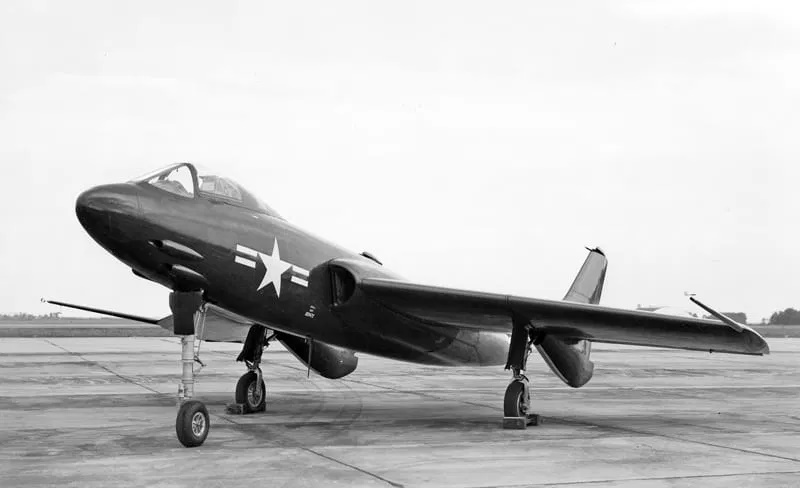
Unlike the Pirate, the Cutlass at least appealing in appearance, incorporating exotic design ideas that had their roots in concepts dreamt up by the German Arado company before the end of the war. It was a "tailless" aircraft, with a rear-set narrow-chord wing featuring a leading-edge sweepback of 38 degrees. "Elevons" took the place of elevators and ailerons, and the wings featured leading-edge slats. Twin tailfins were fitted, one at the midpoint of each wing. The wings folded straight up outboard of the tailfins, giving the Cutlass a compact "footprint" for carrier storage.
The Cutlass was powered by twin Westinghouse J34-WE-22 afterburning engines, with 16.0 kN (1,630 kgp / 3,000 lbf) dry thrust and 18.0 kN (1,930 kgp / 4,250 lbf) afterburning thrust each. The aircraft was armed with four 20-millimeter cannon mounted in the bottom of the nose, had hydraulic flight controls, and a pressurized cockpit.
___________________________________________________________________
VOUGHT F7U-1 CUTLASS:
___________________________________________________________________
wingspan:
11.78 meters (38 feet 8 inches)
wing area:
46.08 sq_meters (496 sq_feet)
length:
12.06 meters (39 feet 7 inches)
height:
3.61 meters (11 feet 10 inches)
empty weight:
5,825 kilograms (12,840 pounds)
loaded weight:
10,900 kilograms (24,000 pounds)
max speed at altitude:
1,080 KPH (670 MPH / 585 KT)
range:
1,810 kilometers (1,125 MI / 980 NMI)
___________________________________________________________________
The Cutlass was indeed an innovative aircraft, but unfortunately it wasn't a very good one. Descriptions of the troubles of the Cutlass are so negative that they're hard to believe. All three prototypes were lost in crashes. The aircraft's performance and fitness for operational duty were judged unacceptable, and all the 14 pre-production aircraft were relegated to training duties, where they suffered from a very high accident rate. In fact, two were said to have crashed even before delivery from the manufacturer.
Two of the F7U-1s were provided for a short time to the Navy "Blue Angels" flight demonstration team, to be used for solo performances along with the Grumman F9F Panthers used by the rest of the team. It would prove to be the type's only moment of distinction. According to a story, a Navy commander asked a Marine lieutenant colonel who had just test flown-one of the XF7U-1s: "What do you think? Is it any good?"
"Nope."
"Well, does it have any potential?"
"Nope."
* Vought struggled to try to set things right with the Cutlass, designing a "F7U-2" that added many improvements, including uprated J34-WE-42 engines. Vought submitted a proposal for the F7U-2 on 1 November 1948 and the Navy ordered 88 -- but due to engine development problems, that variant never flew.
Vought also pursued a complete redesign of the Cutlass, the "F7U-3", with the proposal also submitted on 1 November 1948. Although the F7U-3's configuration was unmistakeably derived from that of the F7U-1, the F7U-3 was almost a completely new aircraft, being substantially bigger, heavier, and more rugged, with a deeper fuselage and more powerful engines.
One particularly noticeable change was that the cockpit was raised to give the pilot a better field of view for carrier landing. The F7U-1 made its approach at a high angle of attack of 20 degrees, a characteristic that pilots disliked and which had led to accidents; Vought engineers hoped the revised cockpit would improve matters. Other changes included the addition of over a hundred new doors and access panels to improve serviceability, and repositioning of the four 20-millimeter cannon in the upper lip of the intakes, instead of the nose. The F7U-3 could also carry 900 kilograms (a ton) of external stores, including drop tanks.
The first F7U-3 flew on 20 December 1951. Although the aircraft was supposed to be powered by Westinghouse J46 engines, delays in engine development meant that the first 16 F7U-3s were all powered by twin Allison J35-A-29 turbojets. Carrier trials of the initial batch demonstrated that still more fixes were required, with the nose redesigned again to improve field of view. Ruggedized nose gear was added as well, with dual wheels instead of the single wheel of earlier F7Us, to reduce the rate of nose-gear failures.
The 17th F7U-3 was full production spec, featuring all these changes and two Westinghouse J46-WE-8 afterburning engines with 20.5 kN (2,090 kgp / 4,600 lbf) dry thrust and 27.2 kN (2,770 kgp / 6,100 lbf) afterburning thrust each. Initial service deliveries began to the US Navy in 1954, with a total of 180 F7U-3s delivered.
___________________________________________________________________
VOUGHT F7U-3 CUTLASS:
___________________________________________________________________
wingspan:
12.09 meters (39 feet 8 inches)
wing area:
46.08 sq_meters (496 sq_feet)
length:
13.13 meters (43 feet 1 inch)
height:
4.36 meters (14 feet 4 inches)
empty weight:
8,285 kilograms (18,260 pounds)
loaded weight:
14,350 kilograms (31,640 pounds)
max speed at altitude:
1,095 KPH (680 MPH / 590 KT)
range (no drop tanks):
1,120 kilometers (695 MI / 605 NMI)
___________________________________________________________________
These aircraft were followed by 98 "F7U-3Ms", which were much the same as the F7U-3, but were modified to carry four Sparrow semi-active radar homing air-to-air missiles (AAM) and additional wing fuel tanks. Twelve "F7U-3Ps" were also built, with a nose lengthened by 64 centimeters (25 inches) to accommodate a suite of reconnaissance cameras. It appears the cannon were deleted.
The last Cutlass to be built, an F7U-3M, was delivered on 12 August 1955. The service life of the F7U proved anything but distinguished. Although some sources say the Cutlass was very rugged and remarkably maneuverable, it was also underpowered, being nicknamed the "Gutless" by pilots. The Westinghouse J46 engines had been designed to provide 31.1 kN (3,175 kgp / 7,000 lbf) dry thrust and 44.5 kN (4,535 kgp / 10,000 lbf) afterburning thrust each. Their actual thrust proved to be about 60% of that; loss of one engine usually meant loss of the aircraft. Westinghouse manufactured household appliances at the time, and one disgusted test pilot later commented that "the Westinghouse J46 engines generated about as much heat as their toasters."
The Cutlass was still dangerous to land, and there were tales of pilots impaled by the nose gear ramming up through the cockpit on hard landings. It also suffered from nasty stall characteristics; a touchy center of gravity; and a tendency to suffer engine flame-outs when the cannons were fired. Even getting into or out of the thing appears to have been an adventure -- the nose gear was so long that when the aircraft was parked, the top of the cockpit was clearly higher than the tips of the tailfins.
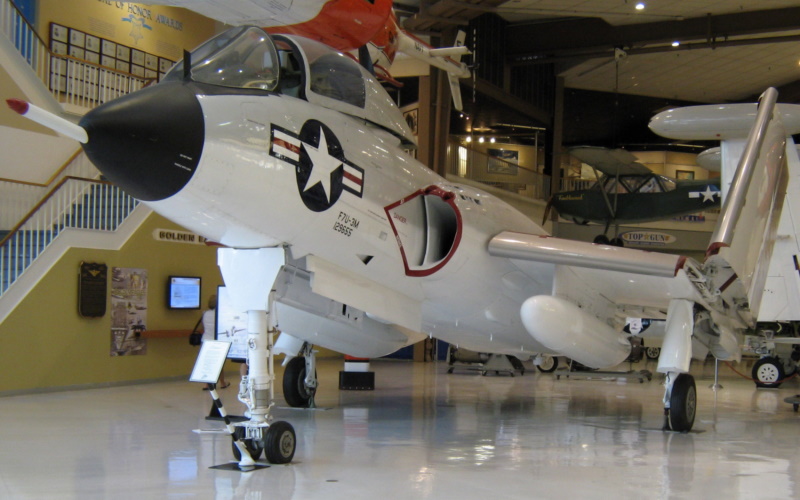
* About a quarter of all F7U-3s were lost in various accidents, with the Cutlass also becoming known as an "Ensign Eliminator". That was a very high loss rate for an aircraft with a short service life -- that never saw combat, and it was good that it didn't. The Navy began withdrawing the F7U-3 from service in 1956, with most out of operation by the end of 1957, though a few persisted until 1959. It was never remembered with any fondness. One pilot called it a "gutless, thirsty dog, with low performance and a miserable range." Another damned it even more bluntly, calling it "an unforgiving, unreliable airplane that took too many lives before it was retired." It is said that some F7Us with less than 50 hours of flight time were simply parked in schoolyards for kids to play on.
The Cutlass won Vought no respect from the Navy. The company would have suffered for it, except for the fact that even as Navy aviators were learning to hate the F7U, Vought was demonstrating they could do vastly better.
BACK_TO_TOP* Vought's third jet fighter began life as a US Navy requirement issued in September 1952, for a carrier-based fighter capable of a top speed of Mach 1.2 at altitude, as well as reliability and serviceability, high maneuverability, and good carrier landing characteristics. Vought and seven other aircraft manufacturers submitted proposals.
The Vought proposal, the "V-383", was designed by a team under John Russell "Russ" Clark. The V-383 was revolutionary, a big step forward in the state of the art; the Navy was intrigued, awarding Vought a contract in May 1953 for mock-ups and wind-tunnel test models. The service also expressed interest in a photo-reconnaissance version, the "V-392".
The Navy quickly followed up the initial contract with a second contract, awarded on 29 June, for two prototypes of the V-383, to be given the Navy designation of "XF8U-1". The first XF8U-1 was rolled out in February 1955, and took to the air on 25 March with Vought's chief test pilot John W. Konrad at the controls. The prototype broke Mach 1 during this initial flight, making it the first fighter designed for shipboard operation to fly faster than sound. The second prototype made its first flight on 12 June. By that time, the new aircraft had been given the name "Crusader".
* The Navy requirement that led to the Crusader was difficult to meet. The overhead that carrier-deck operations imposes on an aircraft, including ruggedized landing gear, arresting hook, and folding wings, necessarily leads to a weight penalty, working against performance. Similarly, high flight performance tends to work against low landing speed, which is particularly important for landing on an aircraft carrier deck.
The Vought engineers came up with a brilliant design to meet the requirement. The most unusual feature of the aircraft was its "variable-incidence" wing, which addressed the landing problems experienced by the Cutlass. On take-off and landing, the XF8U-1's wing could be pivoted up seven degrees, hinging on the rear wing spar and jacked up by a hydraulic actuator. The pilot used a locking handle to ensure that the wing stayed in place in flight, and a positioning handle to raise the wing once the locking handle was released. The wing-raising system had a pneumatic backup in case the hydraulic system failed. The variable-incidence wing scheme allowed the wing to assume a high angle of attack -- reducing the approach and take-off speed -- while keeping the fuselage level and giving the pilot a good forward field of view. It also eliminated the need for the long and stalky nose gear, which had been one of the F7U's major weak points.
Take-off and approach speed were further reduced through the use of a linkage that simultaneously lowered the ailerons and the leading-edge flaps -- which ran the entire leading edge of the wing, with inboard and outboard sections. That increased the effective curvature, or "camber", of the wing, providing more lift at low speed. The wing had a sweep of 42 degrees and a thickness/chord ratio of about 5%. To improve lateral stability, the wings had an anhedral droop of about 5%. The ends of the wings folded straight up hydraulically for storage. These folding portions had no control surfaces, except for the drooping leading edge, and extended slightly in front of the inner portions, forming a "dogtooth" in the wing's outline.
The inner portions of the wing had integral fuel tanks. The ailerons were hydraulically-powered, and were known as "flaperons" because of their additional droop on landing and take-off. There were small landing flaps inboard of the ailerons that drooped slightly more than the flaperons.
The Crusader was built primarily of aluminum alloy, but magnesium alloy was used for about a quarter of the fuselage and wing skins. Parts of the aircraft were made of titanium, particularly the rear fuselage around the afterburner, as well as much of the central structure. The fuselage was designed with the new "area ruling" scheme, in which transonic performance was improved by ensuring that the cross-sectional area of the aircraft changed as gradually as possible, resulting in a design with smooth and pleasing curves.
The forward part of the fuselage contained the avionics bay, followed by the cockpit; then the armament bay, with a backward-retracting nose gear below; and finally a center section containing fuel tanks, all arranged around the engine inlet. The forward-retracting main gear was just forward of the engine. The main gear was surprisingly short and gave the otherwise elegant aircraft a squat appearance on the ground. All the gear assemblies had single wheels.
The last part of the fuselage contained the engine, which in the XF8U-1 prototype was a Pratt & Whitney J57-P-11 turbojet, with 43.2 kN (4,400 kgp / 9,700 lbf) dry thrust and 65.7 kN (6,700 kgp / 14,800 lbf) afterburning thrust. The rear fuselage could be pulled off for engine access. The tailfin was large and tall. The tailplane had a slight dihedral and was of "all-moving" configuration, that is, the entire control surface pivoting as a single piece. A stinger-type arrestor hook retracted flush into the fuselage under the tail section.
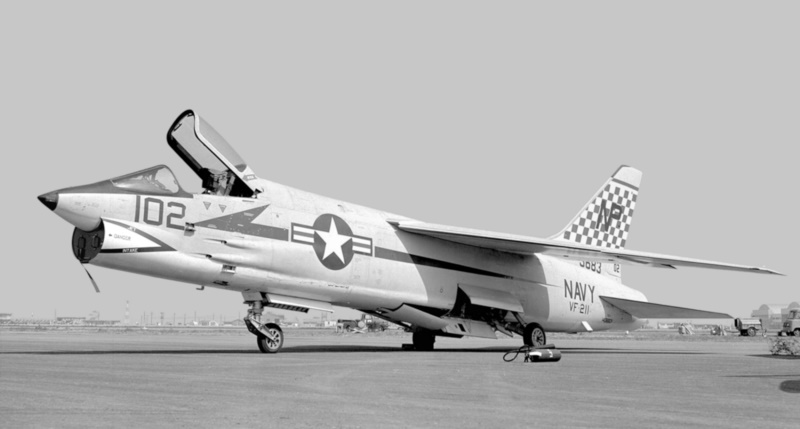
The armament section contained four 20-millimeter Colt Mark 12 cannon with 144 rounds per gun. There were two guns on either side of the nose. The fighter was fitted with an AN/APG-30 radar gunsight, with the antenna in the nose cone, to help aim the guns. Behind the guns, on each side of the aircraft, was a launch rail for a single Sidewinder heat-seeking AAM. There were no wing stores pylons, but the aircraft was fitted with a retractable rocket pack in the belly that stored thirty-two 70-millimeter (2.75-inch) "Mighty Mouse" unguided folding-fin rockets. In production aircraft, the rocket pack would rarely, if ever, be used, and was often sealed shut.
All early versions of the aircraft had a large fuel capacity of 5,300 liters (1,400 US gallons), providing endurance of three hours. The Crusader would rarely fly with drop tanks through its entire career. The pilot sat on a new, lightweight, Vought-designed ejection seat under a clamshell canopy that hinged open on the rear. He got into the aircraft by pulling out a step on the bottom of the fuselage and then clambering up two pop-out handholds / footsteps.
Other features of the aircraft included a dive brake on the belly, directly below the front of the wing, and an innovative Marquardt-built "ram air turbine (RAT)" that could be extended from the right side of the fuselage, directly behind the cannon, for emergency electrical and hydraulic power. The RAT would prove very useful in practice, allowing many pilots to bring home aircraft that would have otherwise been lost.
Later versions of the aircraft would be variations on the pattern of the XF8U-1, adding new features or deleting obsolescent items, but the prototype configuration makes a good baseline for further discussion. Both the prototypes were flown for several more years to test new features for the Crusader, with the first prototype ultimately ending up in the hands of the Smithsonian Museum of Air & Space in Washington DC, and the second prototype scrapped.
BACK_TO_TOP* Prototype flight tests went extremely well, demonstrating that the aircraft could be put into production almost immediately. The first production "F8U-1 Crusader" was rolled out on 20 September 1955, less than six months after the first flight of the XF8U-1.
The production F8U-1 was very similar to the initial prototype -- though after the delivery of the first 50 or so, the type was fitted with an inflight refueling probe that retracted into a blister on the left side of the aircraft, behind the cockpit. The F8U-1 was initially powered by a Pratt & Whitney J57-P-12 turbojet, with similar specs to the P-11 variant but with minor technical improvements. The 31st production aircraft would switch to the J57-P-4A, with 48.6 kN (4,950 kgp / 10,900 lbf) dry thrust and 73.9 kN (7,530 kgp / 16,000 lbf) afterburning thrust.
Service deliveries for operational evaluation began in early 1956. Carrier qualification trials on board the USS FORRESTAL were complete by April 1956, and the US Navy accepted its first operational F8U-1 on 28 December 1956. By March 1957, production of the F8U-1 was in full swing, with the Vought factory in Dallas, Texas, rolling out eight fighters per month. A total of 318 F8U-1s was built.
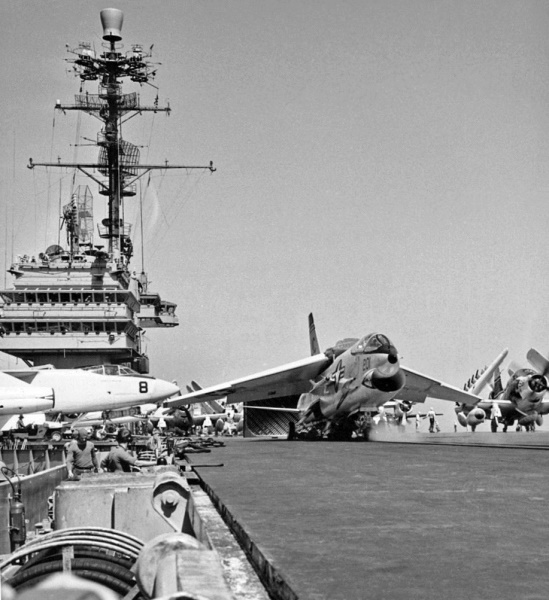
* The Navy also wanted the V-392 reconnaissance variant of the Crusader, and so the 32nd production F8U-1 was pulled off the line and modified to the "F8U-1P" photo-reconnaissance configuration. All armament and the fire-control system were deleted and replaced by a camera array in the bottom of a redesigned forward fuselage.
The reconnaissance camera fit would evolve over time, but the fundamental configuration involved four "stations", with a non-intuitive numbering scheme. "Station 1" was in a blister fitted just forward of the nose gear doors, with a window giving a camera view forward along the aircraft's flight path. "Station 2" was behind the nose gear doors, with camera viewports on the bottom and both sides of the aircraft. "Station 3" and "station 4" were alongside the nose gear doors, though their exact layout seems a little unclear, with various small viewports on the bottom of the aircraft and one large viewport to the left side.
A variety of cameras could be fitted. The station 1 blister could accommodate a 16-millimeter movie camera, though this was rarely done in practice, a still camera being a more normal fit. Early camera configurations generally included a three-axis "trimetrogon" camera in the rear station 2 position, plus vertical and oblique cameras in the other stations. The pilot had a moveable "reticule", mounted on a pantograph arm, to allow him to line up shots to the side of the aircraft, and also had a periscope to help him line up shots below the aircraft. The periscope's viewport was in the bottom of the nose cone, just in front of the engine intake.
The redesigned forward fuselage was big enough to allow the refueling probe to retract completely into the fuselage, eliminating the blister on the left side. The height of the tailfin was also reduced to increase speed. The first F8U-1P flew on 17 December 1957, and a total of 144 was built into early 1960. Making the best use of the F8U-1P required the skills of both a pilot and a photographer. The F8U-1P was not only used for reconnaissance, but also for taking publicity stills of other aircraft for Navy promotional purposes.
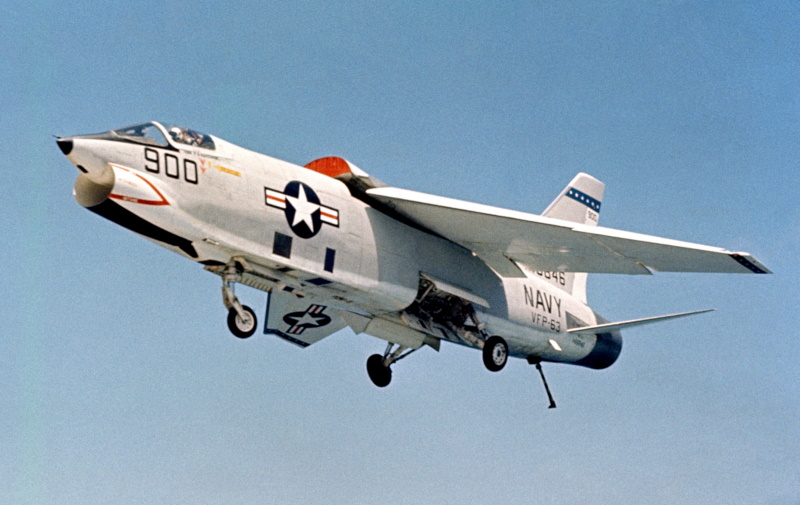
In service, the F8U-1 and F8U-1P were painted gull gray on the top and white underneath, except for the flaps and tailplane, which were white top and bottom. It is unclear why these elements were painted all white; it is possible it was done as a recognition aid.
* Given a new, hot, capable aircraft, the Navy was eager to show the Crusader off. On 21 August 1956, a production F8U-1 set a new speed record of 1,634 KPH (1,015 MPH) over a 15-kilometer (9.3-mile) course above China Lake, California, with Navy test pilot Commander "Duke" Windsor at the controls. The Crusader had already been taken up to 1,770 KPH (1,100 MPH) in test flights, but Windsor had been told only to exceed 1,000 MPH, in order to break a record set by the Air Force with an F-100C in 1955. The Navy did not want to reveal the Crusader's top speed. The speed dash actually did not exceed the current world's record of 1,822 KPH (1,132 MPH), held by the British Fairey Delta 2 experimental aircraft, but it still won the Navy and Vought the Thompson Trophy for that year.
On 6 June 1957, two Crusaders took off from the USS BON HOMME RICHARD in the Pacific, with Captain Robert G. Dose and Lieutenant Commander Paul Miller at the controls. Three hours and 28 minutes later, after a mid-air refueling by a North American AJ-2 Savage tanker near Dallas, Texas, the two aircraft set down on the deck of the USS SARATOGA off the coast of Florida. The two aircraft set an unofficial speed record and performed the first carrier-to-carrier transcontinental flight in history.
Five weeks after that, on 16 July 1957, an F8U-1 and an F8U-1P attempted to set a coast-to-coast speed record under "Project Bullet". The F8U-1P was to photograph the country from coast to coast during the flight from Los Angeles to New York City. The F8U-1 was forced out of the exercise by damage to its refueling probe during a refueling attempt over Albuquerque, New Mexico, but the F8U-1P landed in New York after a flight of 3 hours and 23 minutes, with an average speed of 1,167.63 KPH (725.55 MPH). The pilot was US Marine Major John Glenn, who a few years later would be the first American to orbit the Earth, and would then go on to be a long-standing Democratic senator from the state of Ohio.
* By the end of 1957, the Crusader was equipping operational US Navy and Marine squadrons in numbers. First carrier deployments of the Crusader took place in early 1958, on the USS HANCOCK in the Pacific and the USS SARATOGA in the Atlantic. In the summer of 1958, US President Eisenhower ordered a military intervention of Lebanon, with Crusaders from the SARATOGA providing top cover for landings on 15 and 16 July. They encountered no opposition.
Navy pilots were happy with the Crusader: it was a fighter. Vought had promised the Navy it could do Mach 1.4, but it could actually do Mach 1.7, it climbed like a bat out of hell, and it was muscular in maneuvers. However, it did suffer from a number of teething problems and defects:
The Crusader, like Vought's Corsair, had a high accident rate, about two to three times higher than that of the McDonnell F-4 Phantom and four times that of the later Grumman F-14 Tomcat. However, as had been the case with the Corsair, the Crusader's virtues thoroughly outweighed its vices.
Carrier deck crews were a little intimidated by the Crusader as well. Although the short landing gear made service access easy, it also meant that the jet exhaust blasted low over the deck and could easily sweep an unwary crewman off his feet. The fighter crawled around the flight deck on its squat undercarriage, with its big engine intake looking like open jaws to suck in the careless. Eventually this menacing "attitude" would give the Crusader its nickname: "Gator".
BACK_TO_TOP* The F8U-1 was followed by an improved variant, the "F8U-1E", which had an AN/APS-67 radar system in place of the original AN/APG-30 radar gunsight, giving the F8U-1E a limited all-weather combat capability. A bigger plastic nosecone was fitted to accommodate the larger radar antenna. The F8U-1E was otherwise much the same as the F8U-1, and in fact the first F8U-1E was a modified production F8U-1. First flight was in early September 1958. 130 F8U-1Es were built in all.
* The F8U-1E was followed by the "F8U-2" -- which was referred to at Vought as the "Crusader II", though in practice it would be simply known as the "Crusader" like its predecessors. The F8U-2's main feature was an uprated J57-P-16 engine with 47.6 kN (4,850 kgp / 10,700 lbf) dry thrust and 75.2 kN (7,670 kgp / 16,900 lbf) afterburning thrust, providing much improved performance.
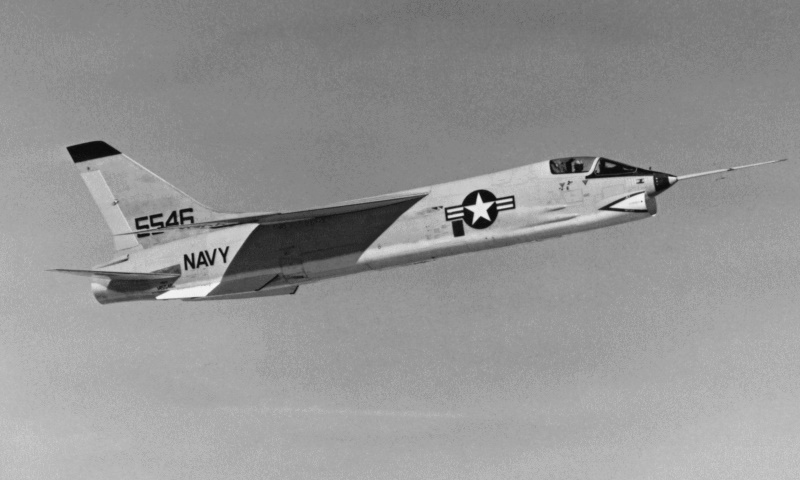
The F8U-2 differed visibly from its predecessors through the addition of two small air intakes on the top of the tailcone for afterburner cooling, as well as twin ventral strakes that were added under the tail to improve directional stability. Few Crusader pilots actually noticed any improvement from the addition of the ventral strakes, but they would be standard for all Crusaders from then on. The keen-eyed might also have noticed that the F8U-2's wingspan was 15 centimeters (6 inches) shorter than that of its predecessors.
Other changes included the replacement of the Vought-designed ejection seat with a British-designed Martin-Baker Mark 5 seat, also retrofitted to older Crusaders, as part of a Navy standardization effort; and a new "Y" rack that allowed carriage of two Sidewinders on each side of the aircraft, for a total of four missiles -- though in operational practice, Crusaders would often still only carry two missiles, since four made the fighter nose-heavy. Some sources claim that the F8U-2 was equipped with an improved radar and fire-control system, but if so details are unclear.
The initial F8U-2 prototype was merely a re-engined F8U-1, and took to the air in December 1957. It was followed in January 1958 by a second that was much closer to production spec. The first production aircraft flew in August 1958. Tests indicated the F8U-2 was capable of almost Mach 2 and had a substantially boosted rate of climb. Production terminated in September 1960, after 187 F8U-2s had been delivered.
* The next version was the "F8U-2N", which was modified for the night fighting role. It incorporated new avionics such as an improved radar / fire control system and a push-button autopilot -- plus another uprated engine, the J57-P-20, with increased afterburning thrust of 80.1 kN (8,170 kgp / 18,000 lbf). The rocket pack was finally deleted, in favor of a greater fuel capacity of a total of 6,130 liters (1,620 US gallons). An AN/AAS-15 "infrared search and track (IRST)" sensor was fitted on most F8U-2Ns, appearing as a knob above the nose cone and in front of the cockpit. The first F8U-2N flew in February 1960, with the initial production aircraft delivered in June of that year. 152 were completed by January 1962.
* The last "new production" Crusader for the US Navy was the "F8U-2NE", which initially flew at the end of June 1961. This variant carried yet another improved search and fire-control radar system for enhanced all-weather operation, dictating a still bigger nosecone that made the aircraft 7.6 centimeters (3 inches) longer. The new "AN/APQ-94" system could search for a bomber-sized target out to a range of 110 kilometers (70 miles) and track such a target out to a range of 75 kilometers (45 miles).
All but the earliest production of the F8U-2NE was strongly enhanced for the strike role through the addition of two removeable underwing stores pylons for Zuni rocket packs, AGM-12 Bullpup radio-guided air-to-surface missiles, or bombs and other stores. Total warload was a maximum of 2,250 kilograms (5,000 pounds). Radio-control avionics for the Bullpup missiles was fitted to the aircraft in a center-wing hump, though the ineffective Bullpup was rarely carried in practice. Early F8U-2NE production was retrofitted with the twin stores pylons. 286 F8U-2NEs were built in all.
___________________________________________________________________
VOUGHT F8U-NE (F-8E):
___________________________________________________________________
wingspan:
10.7 meters (35 feet 2 inches)
wing area:
34.84 sq_meters (375 sq_feet)
length:
16.6 meters (54 feet 6 inches)
height:
4.8 meters (15 feet 9 inches)
empty weight:
8,940 kilograms (19,700 pounds)
max loaded weight:
15,400 kilograms (34,000 pounds)
maximum speed:
1,860 KPH (1,155 MPH / 1,005 KT)
service ceiling:
17,700 meters (58,000 feet)
range:
2,250 kilometers (1,400 MI / 1,220 NMI)
___________________________________________________________________
* The fact that the Crusader made considerable demands on pilot skill for safe operation suggested to some that a conversion trainer might be useful, and so the 77th production F8U-1 was modified as a tandem two-seat trainer, with a new forward fuselage that lengthened the aircraft by 60 centimeters (2 feet). The rear seat was "stepped up" to give the flight instructor an excellent forward view.
Two of the cannon were removed, as was the built-in rocket pack, but the ability to launch Sidewinders was retained. Avionics were updated to F-8E standard. As something of an experiment, the conversion was fitted for short-field landings, with low-pressure tires and a drag chute stowed at the base of the tailfin, allowing it to land in half the space of a conventional Crusader. The resulting "F8U-1T Twosader", as it was called, first flew in early 1962.
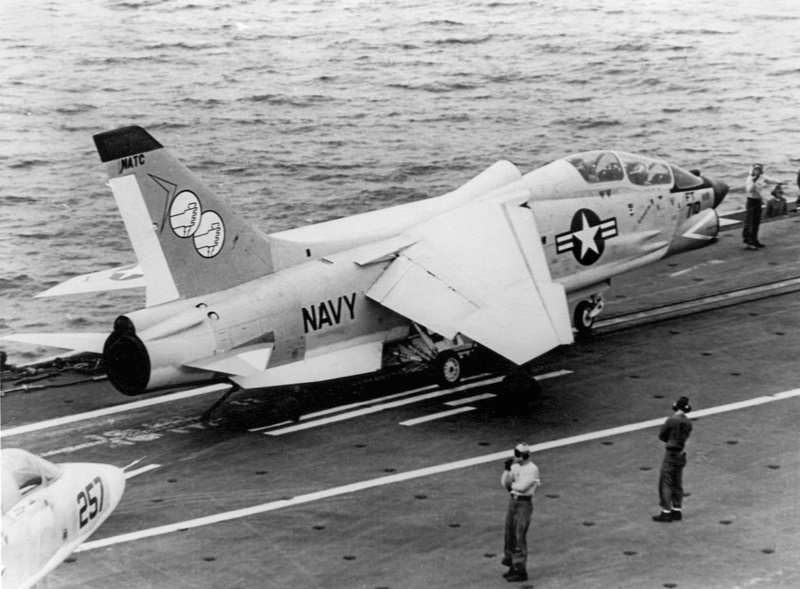
However, budget cuts in 1964 meant no US production orders for the trainer, and only one F8U-1T was ever built. The Twosader was then demonstrated in Europe. The British considered buying the F8U-1T, with various improvements and equipped with a powerful Rolls-Royce Spey afterburning low-bypass fan jet engine, with 53.5 kN (5,450 kgp / 12,000 lbf) dry thrust and 89.3 kN (9,100 kgp / 20,000 lbf) afterburning thrust. That would have resulted in significant improvements in performance and range, but the British opted for the Spey-powered Phantom instead.
The Twosader was passed on to the Navy Test Pilot School at Patuxent River, Maryland, and then on to the US National Aeronautics & Space Administration (NASA). Vought regained use of the Twosader in 1977 to support a sale of surplus Crusaders to the Philippines, but the aircraft was lost in an accident in 1978, both flight crew ejecting safely.
* In September 1962, the US Navy changed their aircraft designation system to the "tri-service" common designation scheme, and existing Crusader variant designations were changed as follows:
The tri-service designations are used in the rest of this document.
* In 1963, Vought became part of the "Ling-Temco-Vought (LTV)" group. Whatever the name, the organization went on to manufacture one more new-production model of the aircraft for a foreign buyer. This was the "F-8E(FN)", built for the French Aeronavale (naval air arm), who had seen the Twosader at the Paris Air Show in 1962, and found the Crusader very attractive. There was one major problem with the sale: French carriers were smaller than American carriers, dictating new engineering to reduce the aircraft's landing speed.
Experiments had been performed some years earlier with a modified early production Crusader to such an end, but the US Navy found the existing landing performance adequate and did not adopt the modifications. However, the experiments pointed the way towards meeting the Aeronavale requirement.
The drooping leading edge of the wing was split lengthwise, while the droop of the ailerons and flaps was also doubled, greatly increasing the camber. A "blown flaps" or "boundary layer control (BLC)" scheme was also added, in which air from the engine's high-pressure compressor was also fed through nozzles over the wings to blow over the flaps, providing lift at low speeds. The wing incidence was reduced by two degrees and the tail was enlarged slightly. The result of the changes was to reduce approach speed by 28 KPH (15 knots). In principle, BLC would make landing the aircraft less of an adventure. The changes were first tested on a modified F-8D in late February 1964, but this aircraft crashed in April. The first production item flew in June 1964 and was used to complete the test program.
Along with the BLC system, the F-8E(FN) featured a Magnavox AN/APQ-104 radar. Some sources claim the IRST was not fitted; the machines were actually delivered with it, but it wasn't all that useful, the Aeronavale judged it more trouble than it was worth, and deleted it.
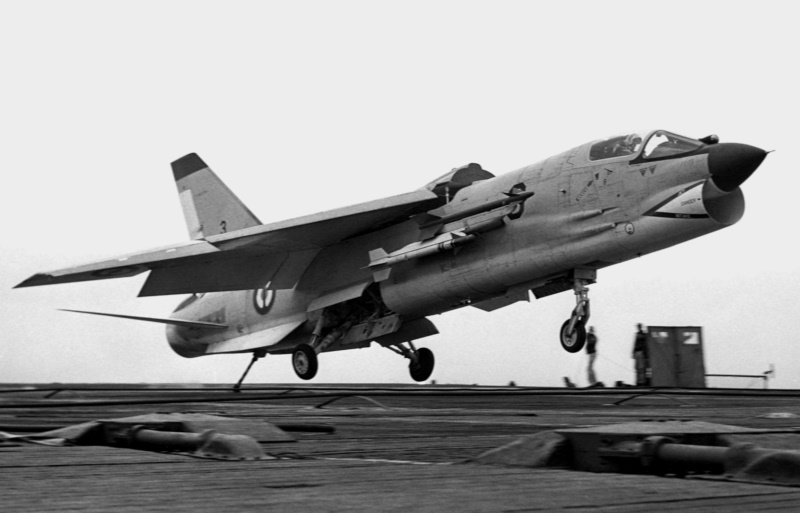
The Aeronavale obtained 42 Crusaders, assigning them to the new carriers CLEMENCEAU and FOCH. The aircraft were initially painted in the same dove gray / white color scheme as US Navy Crusaders, but were later painted overall dove gray. The French aircraft had the same weapons fit as the conventional F-8E, but also had the capability to carry two Matra R.530 AAMs, and eventually would also be able to carry Matra Magic R.550 heat-seeking AAMs in place of Sidewinders -- the Magic was somewhat heavier than the Sidewinder and only two were ever carried. The exhaust from the big Matra R.530 was hotter than that of the Sidewinder and required the installation of small titanium blast deflectors to protect the aircraft.
* The French Crusaders were the very last new-production F-8s built. Total production was 1,261 aircraft, with the list below detailing quantities:
* Beginning in 1964, Crusaders were refitted with an "Approach Power Compensator (APC)" or "auto-throttle", to tame the aircraft's touchy throttle response in carrier deck landings. The APC was a feedback control system that drove the throttle in response to the aircraft's angle of attack and acceleration. The device was engaged when the wing was raised and helped keep approach speed constant. Late model Crusaders were also fitted with the Martin-Baker Mark 7 ejection seat, which provided a "zero-zero (zero altitude and zero speed)" ejection capability not available with the Mark 5. The Mark 7 seat was introduced in 1968.
BACK_TO_TOP* The Crusader proved so valuable to the US Navy and Marine Corps that in 1965 a remanufacturing program was initiated to refurbish existing machines and add enhancements. Improvements included stronger wings with a longer service life, presumably with the option for stores pylons; stronger main landing gear derived from the Vought A-7A Corsair II strike aircraft; a longer and stronger nosewheel strut; plus the double-droop leading edge and BLC scheme devised for the French Aeronavale Crusaders. The BLC scheme required reduction of the wing incidence tilt and increase in the span of the horizontal tailplane.
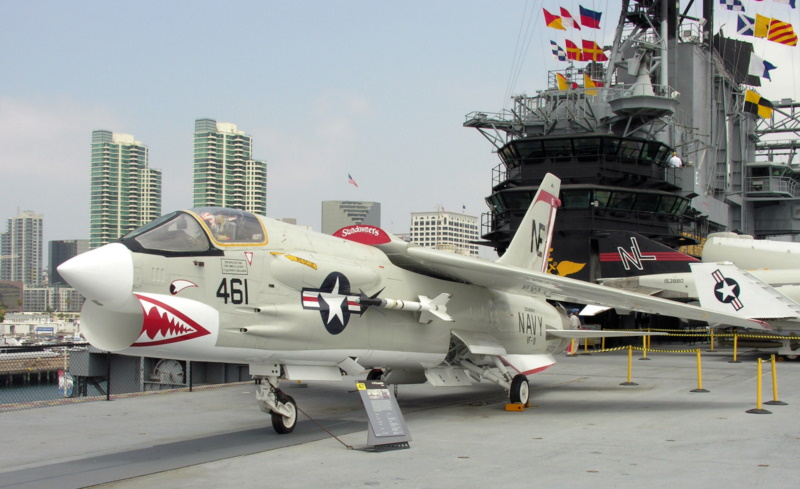
A total of 446 Crusaders was rebuilt, with the following designations:
The upgrades weren't entirely up to a common specification, with some variation in equipment fit. An "F-8M" rebuild of the F-8A was considered, but there weren't enough low-time F-8A airframes left around to make it worthwhile.
The RF-8G featured the reconnaissance Crusader's definitive camera fit. The forward station 1 and the rear station 2 were unchanged, but the middle station 3 & 4 layout was modified, with a panoramic camera in a small teardrop fairing on the left side. The other stations mounted vertical and oblique cameras.
Apparently not all pilots were happy with the upgrades, at least one claiming that the BLC scheme "screwed up" the aircraft. However, the updates kept the Crusader in action. In fact, it was putting in overtime.
BACK_TO_TOP